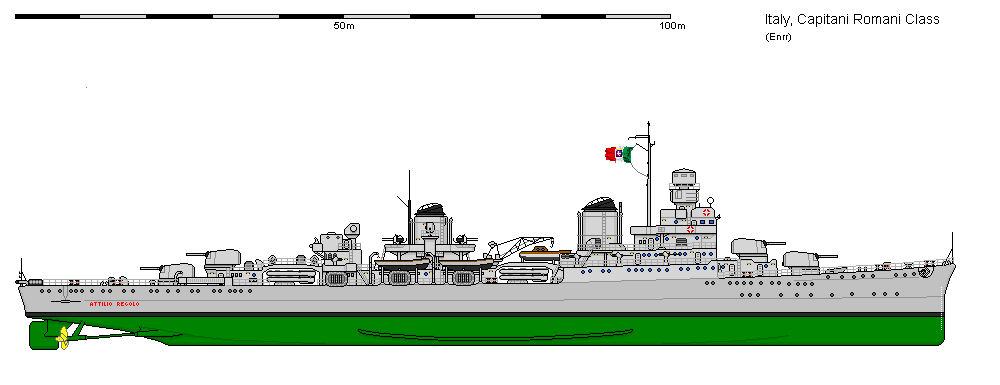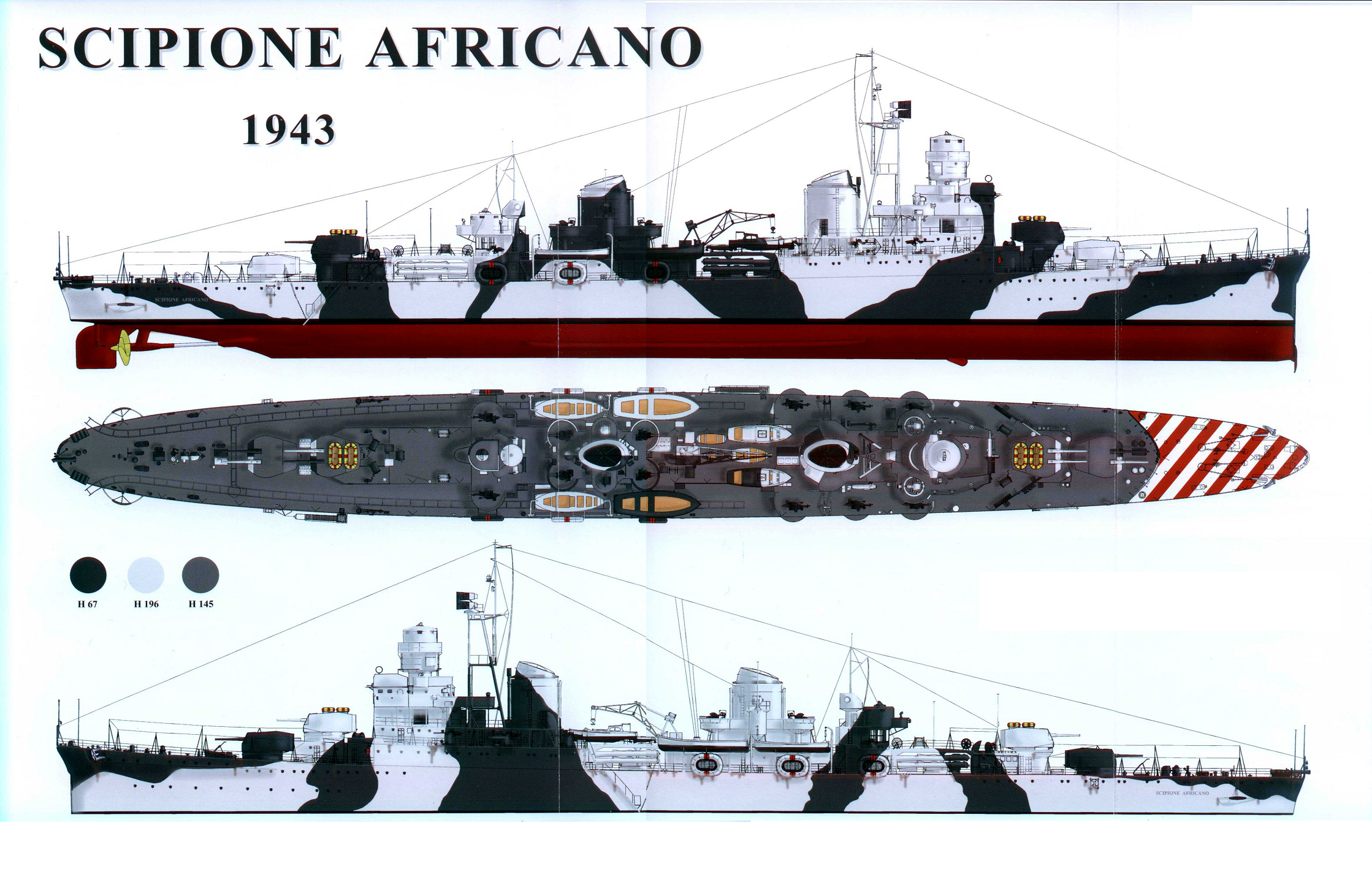RM Giullio Germanico
RM Pompeo Magno
RM Scipione Africano
RM Caio Mario
RM Claudio Drusso
RM Claudio Tiberio
RM Cornelio Sillo
RM Ottaviano Gustavo
RM Paolo Emilio
RM Ulpio Traiano
RM Vipsanio Agrippa
RM Capitani Romani class (CLA-1941)
With the new capital ships being built, new escorts were also
designed and built to act with them. The new fast battleships and carriers
required even faster escorts.

The design above is as it was received by the real life Italian Navy, just
before the Armistice. In real life the completed ship(s) were used as
minelayers. The foes they had been built to fight, (the French Mogador class)
had been scuttled at Toulon in 1942.

Above is my version with updated turrets, dual purpose directors, new torpedo
tube mountings, and light AA equipment.
The first Italian radar sets were the air search sets that they tied into the
gunnery control systems. This gave the heavy and light AA weaponry a much better
knockdown capability. AA predictors were not fitted to the ships till late 1944.
The Italian Navy had been very slow in producing home grown radar electronics.
They may have been better sourcing and producing German electronics which might
have at least given the Italian ships something against the superiority held by the
Commonwealth forces.
Only half the class had been completed by the Armistice. Incomplete hulls were
littered all over the various building yards in differing states of completion.
Of those six ships, three were sunk in various ways (scuttling, bombs, human
torpedoes). The remaining three were completed to a quite different design
utilising American armaments and electronics. The only non US armaments on the
ship in this format were the original Italian torpedo tubes (later removed and
plated in), and the Squid anti-submarine mortar that was sourced from Britain.

In this guise these three ships served in the Italian Navy till the late 1960's,
when they were replaced with more modern vessels. In the 10 year period after
completion, various designs were mooted for the fitting of anti-aircraft
missiles, but this was never seriously looked at. At wars end two of the
completed ships were ceded to France who rebuilt them with new armaments based
on German weaponry.

| Displacement | 3,750 tons std 5,450 tons full load | ||
| Length | 467 ft | ||
| Breadth | 47 ft | ||
| Draught | 14 ft | ||
| Machinery | 2 shaft steam turbines, 110,000shp | ||
| Speed | 41 knots (in light conditions) 36 knots sea speed | ||
| Range | 4500 miles at 18 knots | ||
| Armour | nil | ||
| Armament | Original 8 x 5.3" (4x2) 8 x 37mm (8x1) 8 x 20mm (1x4 4x1)
|
AUW AA Cruiser 8 x 5.3" (4x2) 8 x 37mm (4x2) 10 x 20mm (10x1)
|
US AA Cruiser 6 x 5" (3x2) 6 x 3" (3x2) 1 x Squid
|
| Mines | 70 | nil | nil |
| Torpedoes | 8 x 21" (2x4) | 8 x 21" (2x4) | 8 x 21" (2x4) or nil |
| Complement | 410-425 | ||
| Notes |
RM Attilio Regolo
RM Giullio Germanico RM Pompeo Magno RM Scipione Africano RM Caio Mario RM Claudio Drusso RM Ottaviano Gustavo RM Paolo Emilio RM Ulpio Traiano RM Vipsanio Agrippa |
||

Real life construction and disposition of the class. I have them being completed
a year or two earlier so that they may act as escorts to the modern carriers and
battleships, that I have given the Italian Navy. (source Wikipedia)
| Ship | Namesake | Builder [5] | Laid down[5] | Launched[12] | Completed [12] | Operational history [12] |
|---|---|---|---|---|---|---|
| Attilio Regolo | Marcus Atilius Regulus | O.T.O., Livorno | 28 September 1939 | 28 August 1940 | 15 May 1942 | Commissioned in August 1942 and used as a mine-layer until seriously damaged by a torpedo in November. Ceded to France in 1948 renamed Châteaurenault. |
| Giulio Germanico | Germanicus | Navalmeccanica, Castellammare di Stabia | 3 April 1939 | 26 July 1941 | 19 January 1956[13] | Captured by the Germans in Castellammare di Stabia while under completion, and scuttled by them on 28 September 1943. Raised and completed for the Italian Navy after the war. Renamed San Marco, she served as a destroyer leader until her decommission in 1971. |
| Pompeo Magno | Pompey the Great | CNR, Ancona | 23 September 1939 | 24 August 1941 | 4 June 1943 | Renamed San Giorgio, served as a destroyer leader until 1963; decommissioned and scrapped in 1980 |
| Scipione Africano | Scipio Africanus | O.T.O., Livorno | 28 September 1939 | 12 January 1941 | 23 April 1943 | Ceded to France in 1948 and first renamed S7, then renamed Guichen; scrapped 1979 |
| Ship | Namesake | Builder [5] | Laid down[5] | Launched[12] | Operational history [12] |
|---|---|---|---|---|---|
| Caio Mario | Gaius Marius | O.T.O., Livorno | 28 September 1939 | 17 August 1941 | Captured by the Germans in La Spezia, with only the hull completed; used as a floating oil tank and scuttled in 1944 |
| Claudio Druso | Nero Claudius Drusus | Cantiere del Tirreno, Riva Trigoso | 27 September 1939 | N/A | Construction cancelled June 1940, scrapped between 1941 and February 1942 |
| Claudio Tiberio | Emperor Tiberius | O.T.O., Livorno | 28 September 1939 | N/A | Construction cancelled June 1940; scrapped between November 1941 and February 1942 |
| Cornelio Silla | Lucius Cornelius Sulla | Ansaldo, Genoa | 12 October 1939 | 28 June 1941 | Captured by the Germans in Genoa while fitting out; sunk in an air raid in July 1944 |
| Ottaviano Augusto | Emperor Augustus | CNR, Ancona | 23 September 1939 | 28 April 1941 | Captured by the Germans in Ancona while under completion; sunk in an air attack on 1 November 1943 |
| Paolo Emilio | Lucius Aemilius Paullus Macedonicus | Ansaldo, Genoa | 12 October 1939 | N/A | Construction cancelled in June 1940, scrapped between October 1941 and February 1942 |
| Ulpio Traiano | Emperor Trajan | CNR, Palermo | 28 September 1939 | 30 November 1942 | Sunk 3 January 1943 by British human torpedo attack while fitting out in Palermo |
| Vipsanio Agrippa | Marcus Vipsanius Agrippa | Cantiere del Tirreno, Riva Trigoso | October 1939 | N/A | Construction cancelled June 1940; scrapped between July 1941 and August 1942 |